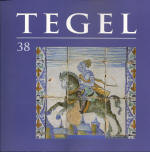 bevat artikelen over de volgende onderwerpen:
bevat artikelen over de volgende onderwerpen:
Prent en tegel
Zeventiende-eeuwse tegeltableaus naar prenten van Goltzius en De Gheyn
Prosper de Jong - pagina 4
Omstreeks 1982 is in Amsterdam een serie van zes veelkleurige tegeltableaus uit de vroege zeventiende eeuw (tussen 1608-1625) opgegraven. De tableaus tonen Romeinse helden, ruiters en een soldaat, gebaseerd op prenten van Hendrick Goltzius en Jacques de Gheyn II. Twee vergelijkbare tegeltableaus, naar prenten van Crispijn de Passe I en De Gheyn, zijn in bezit van het Rijksmuseum Amsterdam. De productieplaats is vooralsnog niet vast te stellen, maar er lijkt een verband te bestaan met de latere productie van blauwe tegeltableaus met een poortomlijsting. De keuze voor Romeinse helden en soldaten op tegels komt wellicht voort uit de strijd tegen de Spaanse overheersing. Dergelijke tegeltableaus werden oorspronkelijk mogelijk links en rechts in een haardachterwand aangebracht.
Tekfur Sarayı: Een korte maar fascinerende periode in de Turkse tegelgeschiedenis
Hans Theunissen - pagina 12
Omdat de tegelaanvoer uit Iznik en Kütahya stagneerde, nam grootvizier Ibrahim Paşa het initiatief tot de oprichting van een aantal nieuwe tegelateliers in Istanbul dat rond 1720-1725 van start ging. In deze ateliers, gevestigd in het voormalig Byzantijnse paleis Tekfur Sarayı, werkten vaklui uit Iznik en mogelijk ook uit Kütahya. Het vraagstuk of de ateliers nog na 1735 actief waren kan bevestigend beantwoord worden door de vondsten van tegels in Cairo in gebouwen uit de jaren 1745-1751.
De beschikbaarheid van tegels van de Tekfur Sarayı ateliers lijkt beperkt te zijn geweest tot voornamelijk de elite van het Osmaanse Rijk: de sultan en zijn belangrijkste hoogwaardigheidsbekleders. Dit verklaart waarschijnlijk ook de opmerkelijk snelle en diverse stilistische ontwikkelingen in de relatief korte bestaansperiode van de ateliers van ca. 1725-1751, waarin naast de revivalist style de mode van de Tulpenperiode (1728-1735) en de barok-rococo (vanaf ca. 1745) op de voet gevolgd werden.
De molen op tegels
Marten Boonstra - pagina 19
Windmolens zijn al vele eeuwen een markant deel van het Nederlandse landschap, en dat vinden we terug in de vele achttiende- en negentiende-eeuwse landschapstegels met molens. Op de tegels zijn verschillende typen molens te onderscheiden, waarbij ook omlijstingen en hoekmotieven verschillen. De afgebeelde tegels dateren van ca. 1675 tot ca. 1940.
Frederick Garrard en zijn kopieën van Nederlandse tegeldecors
Chris Blanchett - pagina 27
Frederick Garrard vervaardigde rond 1900 in zijn aardewerkfabriek in Millwall een serie tegels die gebaseerd was op authentieke zeventiende-eeuwse Nederlandse veelkleurige tegels. Hiermee kwam hij tegemoet aan de door de Arts & Crafts Movement ontstane vraag naar handgemaakte tegels. Zijn tegels worden vaak aangezien voor originele Nederlandse tegels. Dit artikel verschaft duidelijkheid over het hoe en waarom van Garrards tegels. Ook wordt behandeld hoe ze geproduceerd werden en hoe ze te herkennen zijn.
Wisselwerking van decors van verschillende fabrikanten
Jan Pluis - pagina 34
In de loop van de eeuwen werden decors voor tegels of aardewerk niet alleen nieuw ontwikkeld, maar ook opnieuw gebruikt of gekopieerd door andere tegel- en aardewerkfabrieken. In een aantal gevallen nam een tegelschilder sponsen mee bij verhuizing naar een ander bedrijf. Utrechtse decors van bijbeltegels uit de zeventiende eeuw zien we in het begin van de achttiende eeuw op Harlinger tegels en Harlinger motieven worden rond 1800 op Utrechtse tegels aangetroffen. Een (mogelijk Delftse) reeks sponsen met krijgslieden is deels in Rotterdam, deels in Harlingen terechtgekomen.
Eind negentiende eeuw vindt een dergelijke uitwisseling op internationale schaal plaats tussen industrieel vervaardigde tegels uit Duitsland en Engeland en de Nederlandse handgeschilderde tegels.
Passie hoeft niet, hobby is genoeg
Interview met Lida Brouwer-Brand
Lejo Schenk - pagina 43
Lejo Schenk
pagina 43
In dit interview blikt de in 1917 geboren Lida Brand-Brouwer terug op haar leven en gaat in op haar belangrijkste hobby (niet passie!): het verzamelen van tegels. Ze vertelt hoe haar belangstelling zich van tegels uitbreidde naar prenten. Met name vanuit die wisselwerking leverde zij een groot aantal bijdragen aan jaarboek Tegel. Vooral op haar artikel over bloemen op zeventiende-eeuwse tegels (1991) wordt uitvoerig teruggeblikt.





